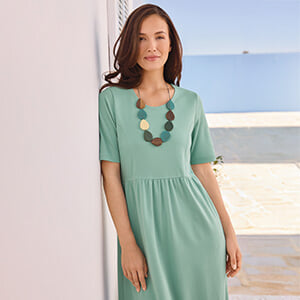
To celebrate National Mills Weekend on the 13th and 14th May, we went behind-the-scenes at our local silk mill, Beckford Silk.
The journey to Beckford is filled with picturesque Cotswold cottages and stunning scenery and as we pull up into the drive we are presented with the beautiful red brick building, surrounded by lush green fields, that is Beckford Silk.

Working with Beckford Silk for over two decades, our accessories buyer Michelle produces beautiful designs for our collections that you will treasure for years to come.

Beckford Silk is a family-run company with nearly half a century of silk printing expertise behind them. Founded in 1975 by James and Marthe Gardner, who wanted to make things by hand in the Cotswold countryside, much the same as the Arts and Crafts Movement, from which we draw our heritage. Their first order was from the National Trust in 1978, which propelled them into the silk printing industry. They have been working with their silk supplier for over a decade, ensuring close ties and a great working relationship.

Marthe and James are still the figureheads of the business but have passed most of their knowledge onto their children Anne and Robbie. Marthe is pictured here with her daughter Anne, who now oversees the design and sales side of the business. It was a pleasure to meet this charming mother & daughter team and to hear how the company has progressed over the years. Surrounded by ledgers filled with accounts, Marthe relaid tales in her delightful French accent of her childhood and her current struggle with all things computer-based (something many of us can relate to), preferring instead to manage the accounts with pencil and paper, whilst liaising with her son. This meeting of the old and the new is a reflection of the business as a whole: Beckford Silk use both screen and digital methods to print, with old methods used side by side with new, as well as the knowledge being passed down the generations. It is this fusion of both that drives the business and leads it forward.

Their in-house designer Victoria works with each client to produce the designs which are then printed. She is currently working with the V&A on over a dozen designs this year and also works with many other institutions, such as the National Trust, Highgrove, Westminster Abbey, the Tate and the Royal Academy, to create high-quality products that reflect the unique heritage of each client.

Their building is filled with the trappings of a working mill, as well as historical artefacts, such as these intricately carved antique silk print blocks.

We are shown into the hub of production, where their exclusive dyes are formulated and recorded in recipe books that have taken years to refine. It is an on-going scientific process, involving a lot of time and experimentation. This room is crammed with intriguing pots that are filled with eye-catching colours, vaguely reminiscent of chemistry lessons. It is a visual feast that belies the hard work behind these amazingly colourful dye recipes.

Here reams of cloth are spinning on machines that use steam to open up the silk fibres, which aids absorption of the dye molecules. They are used to dye their rolls of silk which they sell to designers and the general public.

We are then shown upstairs to the screen printing room. This light and airy room houses the traditional printing process. Giant screens are used to impart the dye onto the silk. One screen is used for each colour. The silk is taped down onto the canvas-covered table and then the screen is placed on top and the dye pushed through. The screen is moved down the table as the fabric is printed. This is also the method used to produce devoré fabric. Once printed the length of silk is pegged up to dry above the table. It is a time-consuming but rewarding process that is keeping this traditional craft alive.

One of the final stages of this complex process is steaming the silk, which ensures that the dye is fixed and any coating is removed. They use a Clip Stenter Finishing Machine, which feeds the fabric through an infra-red oven, drawing out the moisture leaving the fabric dry and crease-free. The silk is then cut into individual scarves, which are hand-rolled by a team of local women, who range from young mothers to experienced seamstresses, including one who has worked for them for over a decade.

The finished items are then boxed and shipped to their clients or displayed in their well laid-out shop.
Anne's knowledge and passion for her family's mill, combined with her easy manner and genuine interest in answering our many questions on the tour, makes it easy to see why Beckford Silk are so successful, adapting readily to the changing world of printing.
We hope you have enjoyed discovering the complex processes involved in producing our scarves and the family behind the brand, as we did.

Shop our classic spot Silk Neckerchief from Beckford Silk and look out for more of their stunning scarves in our upcoming collections.
Visit a mill near you! Take a look at the National Mills Weekend website to find one near you >
Do you own one of our Beckford Silk scarves? Let us know by leaving a comment using the box below.
You have requested to switch to our Cotswold Collections store.
Do you want to continue?


